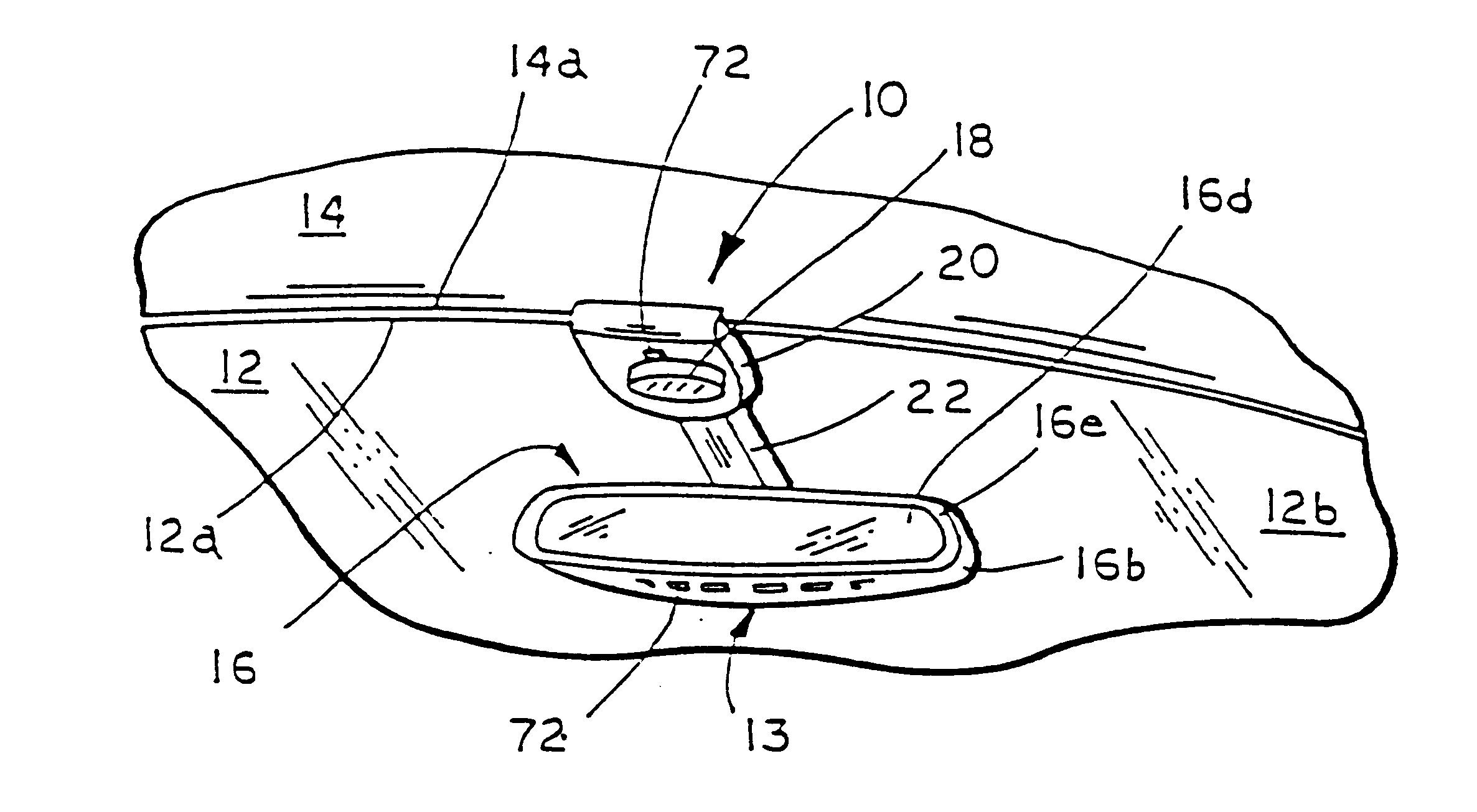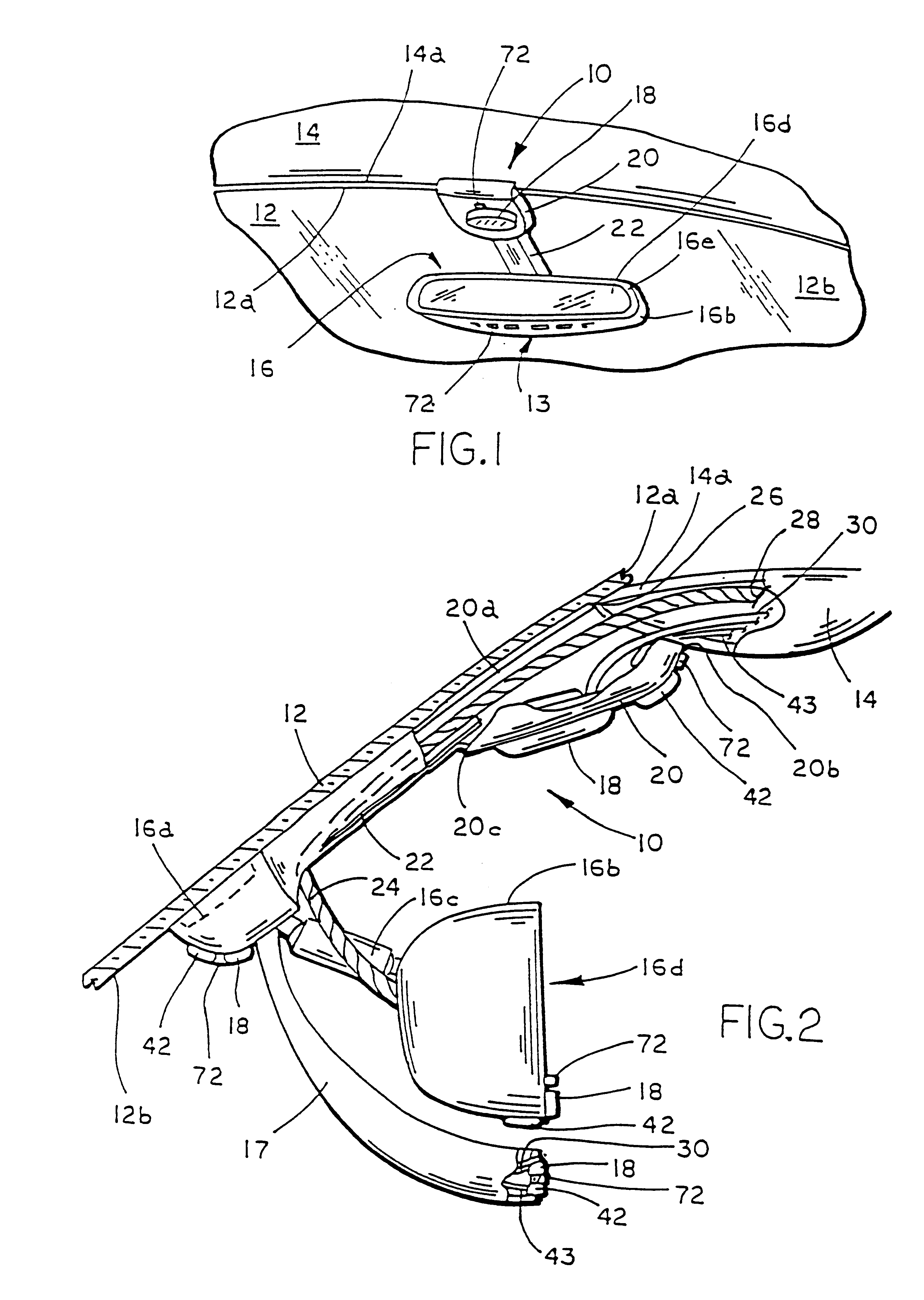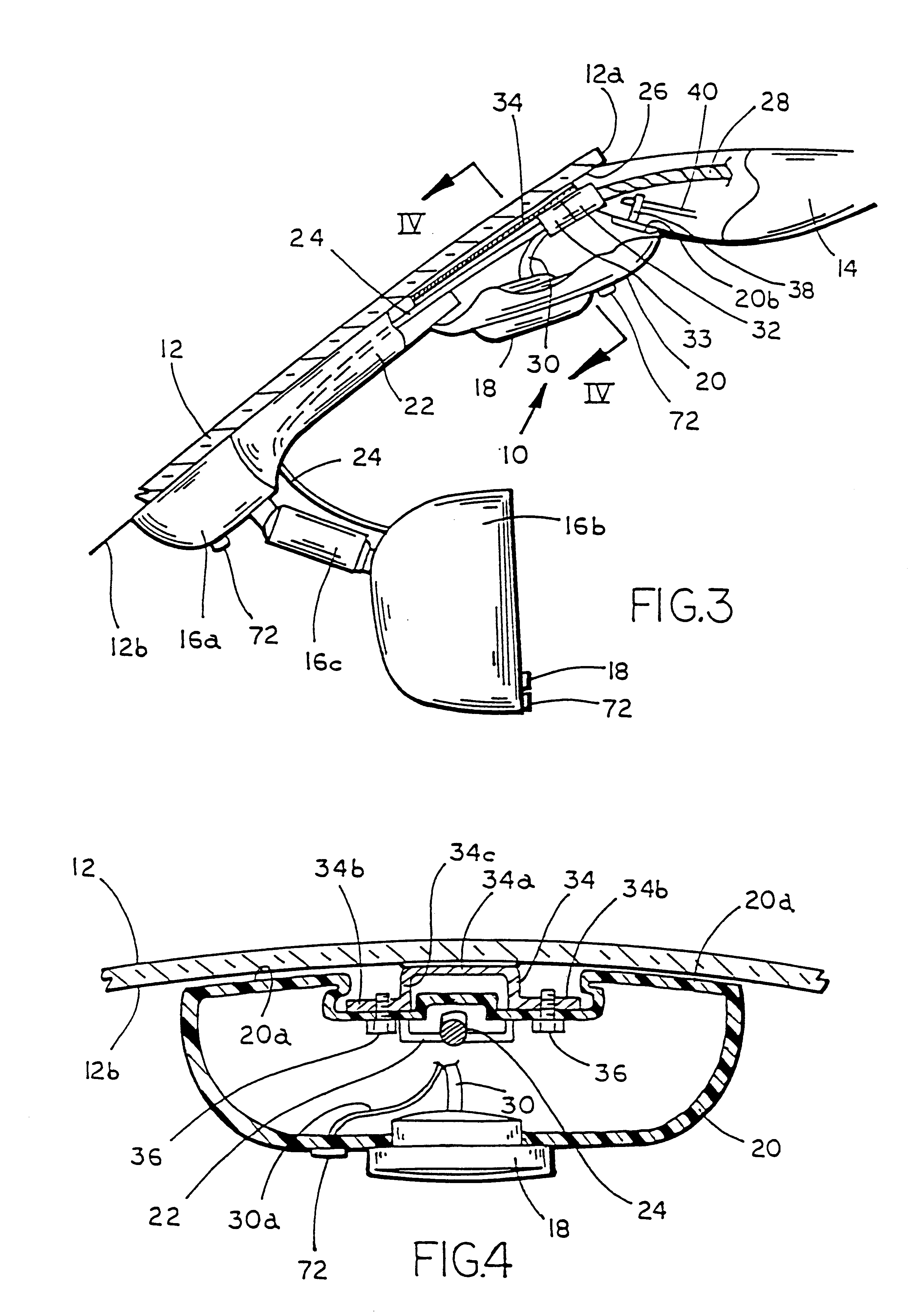The present invention is intended to provide an indicator for a microphone or accessory module, and preferably for an indicator for a microphone mounted in, at or on an interior rearview mirror
assembly to comprise part of an interior rearview mirror system. The microphone or accessory module preferably mounts along an upper, inner edge of the
windshield of a vehicle to direct the microphone, which is preferably a polar or
directional microphone, generally downwardly and rearwardly toward the driver of the vehicle, and most preferably, towards the head of the driver, in order to best pick up vocal communication from the driver's mouth. The indicator provides an indication
signal, preferably a visual indication signal, to the user of the microphone which indicates whether the
voice communication from the user is adequately being received and preferably whether the communication is adequately being discriminated from other audible inputs received by the microphone that are non-vocal. Thus, the indicator provides an indication signal that an adequately high vocal signal to audible non-vocal
noise discrimination ratio is occurring. The accessory module is adaptable for use on a vehicle with a rearview mirror which is separately mounted on the interior surface of the
windshield such as a button mounted rearview mirror, and may further include a wire cover extending downwardly from the module to the mounting button of the rearview mirror. The wire cover functions to cover any mirror wiring harness which may connect the rearview mirror
assembly to a vehicle wiring harness, typically within the headliner of the vehicle.
According to an aspect of the present invention, an audio system for a vehicle comprises a microphone and an indicator. The vehicle has a cabin and a
windshield. The microphone is operable to receive audio signals from within the cabin. The audio signals include vocal signals generated by the human voices of vehicle occupants. The indicator is operable to communicate a receiving status of the audio signals to a user of the audio system and is adapted to indicate to the driver and / or other occupants of the vehicle that a voice generated vocal signal is being appropriately received by the audio system that the microphone feeds, and that the vocal signal is being appropriately and substantially discriminated compared to other audible non-vocal signals picked up by the microphone, such as
HVAC noise,
wind noise, music and the like. The indicator may communicate a receiving status of the microphone and / or a receiving status of another party remote from the vehicle. Thus, the indicator operates to confirm to the driver that verbal inputs / commands / messages / sentences, as spoken by the driver have been received at the microphone and processed by the audio system with sufficient
clarity and volume, such that the verbal inputs / commands / messages / sentences have been adequately correctly received. This is of particular importance when the driver and / or occupants of the vehicle are communicating via the microphone / audio system in the vehicle via
radio transmission to a
receiver remote from the vehicle. Such remote receivers can provide a variety of services that are selected by and / or are dependent on clear and audible voice input received from the vehicular audio system. For example, a concierge-type service can be provided, whereby a restaurant, address, etc., listing can be provided. Also, the vehicle occupant may be voice communicating with an automatic
computer based service, such as airline reservation services and the like, where the driver must select menu items through verbal input of an
alphanumeric (typically a number) input. Lack of
clarity and / or volume and / or the presence of noise may lead to an incorrect selection at the remote receiving party, unbeknownst to the vehicle based driver and / or occupant. The indicator of the present invention thus provides to the driver and / or occupants of the vehicle an indication that verbal input to the audio system in the vehicle is being adequately correctly received by the audio system in the vehicle and / or, more preferably, is being adequately received after transmission to the remote
receiver. Thus, by having an adequately clear reception by the remote
receiver external to the vehicle confirmed back to the vehicular audio system, and by having this indicated to the driver and / or other occupants by the indicator of the present invention, protection is provided against inadequate communication, even caused by interference during the transmission from the vehicle to the remote receiver or receiving party.
According to another aspect of the present invention, an accessory module comprises at least one microphone for receiving audio signals from within a cabin of a vehicle, at least one indicator, and a housing for mounting the microphone. The vehicle includes a windshield, an interior rearview mirror mounted to an interior surface of the windshield, and a headliner extending along an upper edge of the windshield. The indicator is operable to communicate a receiving status of the audio signals to a user of the audio system. The housing for the microphone is preferably mountable between the headliner and the rearview mirror. The microphone and indicator of the accessory module (and any other accessory housed within the accessory module) are electronically connectable to a vehicle wiring within the headliner. Preferably, accessories, such as the microphone and the indicator, are detachably connectable to the vehicle wiring, such as by a plug and socket connector (for example, a multi-pin electrical plug and socket connector system), so that the module can be optionally installed to the vehicle with ease. This is particularly advantageous in circumstances when the interior mirror is a non-electrical mirror, such as a base prismatic mirror.
Accordingly, the present invention provides an indicator for a microphone or accessory module for use with an audio system, such as a hands-free
cellular telephone, audio recording device, emergency
communication device or the like. The indicator provides a signal to a user of the audio system which communicates whether a human vocal
audio signal being received by the audio system is above a threshold level and / or is at least substantially discriminated from other audible noise, so that the vocal signal to non-vocal audible signals received by the audio system from the microphone exceeds a predetermined threshold ratio. Preferably, this ratio is at least 2:1. Most preferably, this ratio is at least 10:1. The microphone and indicator may be mounted in the vehicle cabin, and preferably is mounted as part of the interior rearview mirror system. The accessory module may contain the microphone and / or the indicator and is preferably mounted above the mirror between the mirror and the headliner of the vehicle, which provides a fixed location of the microphone for maintaining proper orientation of the microphone with respect to the vehicle interior. The indicator may be mounted at the accessory module, a rearview mirror housing, behind the mirror reflector in the housing so as to illuminate through the reflector, a rearview mirror mounting portion or a headliner of the vehicle. Because the accessory module is a separate component from the mirror and headliner, additional mirror or headliner console components for mounting the microphone are not required. The present invention facilitates fewer parts in the assembly
plant since the headliner and mirror assembly may be the same part regardless of whether the audio or
communication device associated with the invention is to be installed within the vehicle. Furthermore, because the accessory module does not require special headliners or mirrors, the accessory module may be easily installed as an aftermarket device.
 Login to View More
Login to View More  Login to View More
Login to View More 


